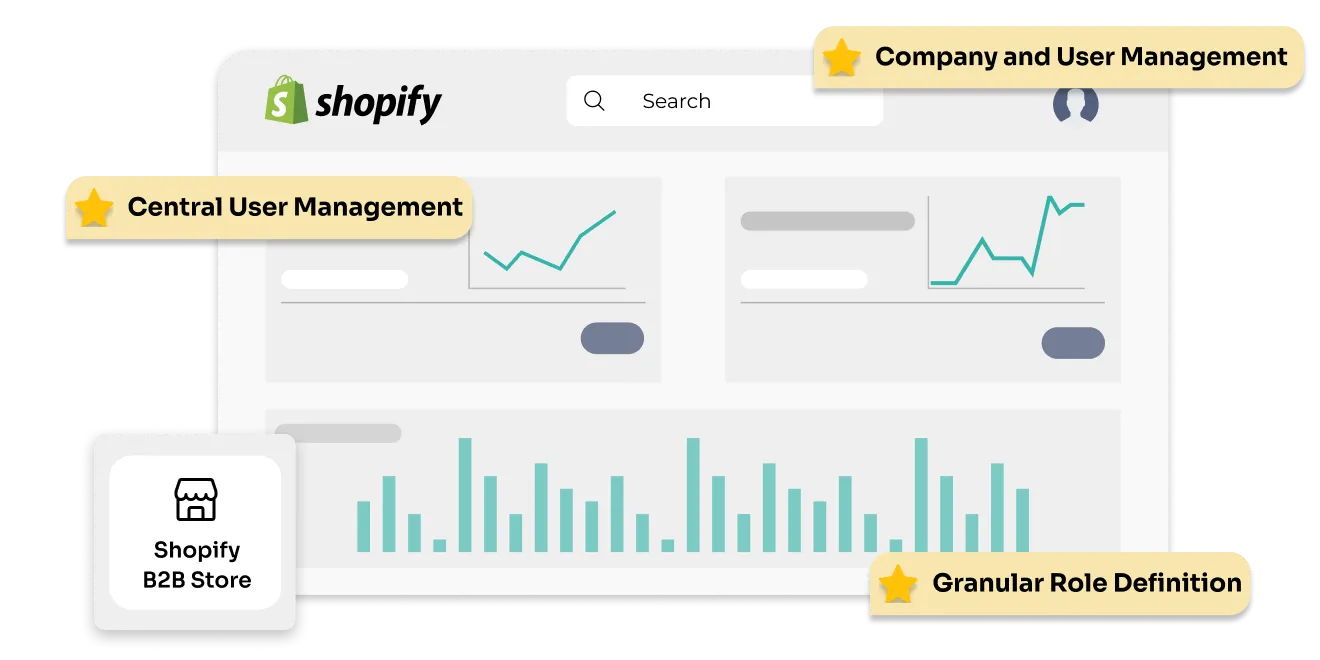Streamline Organizational Complexity on Shopify with Advanced Role Management
As the e-commerce sector grows, businesses that work using the Shopify platform have new challenges regarding their organizational structures. For smaller businesses, the applications that Shopify provides are enough. But as businesses expand, especially B2B companies, there are limited role customization and inefficiencies in managing multi-level hierarchy management in Shopify.
The report centers on Shopify and examines the problems faced by large-scale businesses operating on this platform and ways of tackling them. From Shopify centralized user management to detailed management of organizational roles and implementing a hierarchical structure for the organizations, we will assist you in enhancing efficiency during your business processes.
Challenges in Managing Organizational Complexity on Shopify
Challenge 1: Limited Assignation of Roles
There are some basic user roles in Shopify which include admin, staff, as well as manager roles. While these work for smaller teams, larger organizations need more granular role assignments to determine who has access to what.
For example, a multi-departmental brand that sells on Shopify on an international level is likely to require specific permissions such as;
- Marketing Teams: Having access to analytics and email campaign features but are not able to handle any sort of refunds.
- Customer Support Teams: Are allowed to only view order details but are restricted from modifying the inventory.
In the absence of specific roles, companies are left with no options but to depend on store admins which can be inefficient and leave room for security threats.
Challenge 2: Lack of Multi-Level User Management
Shopify does not have an inbuilt hierarchical structuring for companies having multiple departments, child companies, or partner companies. The lack of hierarchical structure for organizations, causes the organizations to employ unnecessary rudimentary methods which tend to be time-consuming and inefficient.
Let us take the example of a B2B wholesale distributor that has different regional branches operating under different brands. Each branch, as the need arises, will want to have specific permission settings, roles, and access to localized data. Without taking assistance from these services, businesses will have to:
- Create separate stores for each branch, increasing costs and silos.
- Operate all the branches through one store which results in operational mistakes and embarrassment.
Challenge 3: Inefficiencies in Delegating User Permissions
Shopify does not allow administrators to create custom user roles or delegate permissions easily. For example:
- A logistics company handling multiple client accounts may need clients to manage their own teams.
- Clients may want their team members to perform specific actions like viewing invoices or tracking shipments without needing admin intervention.
The inability to create client-specific roles leads to inefficiencies and increased dependency on the Shopify admin.
Why Businesses Need Advanced User Management Solutions
As businesses scale, they require tools that enable Shopify centralized user management, granular role assignments, and hierarchical structures for organizations. Here's how these features solve the pain points:
1. Centralized User Management
Most organizations or businesses operate on multiple levels or have various departments which all have users that require different levels of permissions. Having all structures and their users well organized on one platform greatly enhances efficiency. Organizations can level structure their employees hierarchically distributing the company in any way. Businesses can do the following:
- Create parent-child company structures.
- Assign roles at an organizational or departmental level.
- Have a comprehensive control system for all roles and permissions across all levels.
2. Granular Role Assignments
With advanced user management, businesses can allocate specific roles to different departments such as:
- Business analysts have viewing privileges with appropriate access.
- Employees have limited privileges in certain areas.
- Department Heads are the only authorized personnel to alter permissions.
3. Hierarchical Structures for Organizations
A hierarchical model enables better collaboration and oversight by aligning user access with the organization’s structure. For example:
- Parent companies can manage permissions across child companies.
- Regional managers can oversee localized teams while maintaining operational independence.
The Impact of Centralized User Management in Shopify
Streamlined Operations
Centralized user management reduces administrative overhead by enabling businesses to assign roles and permissions efficiently. This ensures smoother day-to-day operations without constant admin intervention.
Enhanced Security
With granular role assignments, sensitive information is accessible only to authorized users, minimizing risks associated with unauthorized access.
Improved Scalability
Hierarchical structures allow businesses to scale their operations without creating inefficiencies. Whether onboarding new branches or expanding teams, these systems ensure seamless integration.
Conclusion
Managing organizational complexity is a growing challenge for businesses on Shopify, especially for B2B companies or multi-department enterprises. The platform's default user management tools, while functional for small teams, fall short when it comes to advanced needs like Shopify's centralized user management, granular role assignments, and hierarchical structures for organizations.
By adopting solutions tailored to these challenges, businesses can streamline their operations, enhance security, and focus on growth. Whether you're managing a multi-branch B2B enterprise or scaling your e-commerce store, investing in advanced user management capabilities will set you up for long-term success.
Author





Leave a Comment